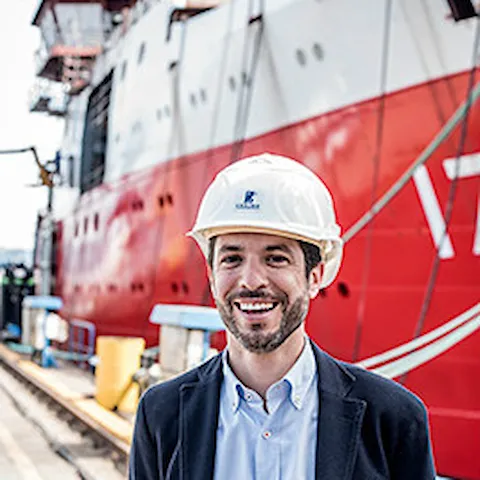The complete toolkit for the Antarctic
Oceanographic Research Vessel
In Vigo, on the north-western coast of Spain, Freire Shipyard has constructed one of the world’s most advanced polar oceanographic research vessels, classed by DNV. During the building phase, Freire’s Director of Production Luis Santos gave a tour of the construction site.
More than 10,000 kilometres from where she will be deployed, B.A.P Carrasco is taking shape. With about 75 per cent of the 95-metre vessel completed, she is already afloat. Inside the hull sparks fly in every direction, and many rooms smell of freshly welded steel. “We are at the outfitting stage. About 150 people are currently routing 160 kilometres of cable and the piping, installing the panelling and fitting the consoles onto the bridge,” says Luis Santos, Director of Production at Freire Shipyard, pulling a sheet of bubble wrap off a dynamic positioning (DP) console.
During DP manoeuvres, the DP operator will face towards the aft where most of the vessel’s sensitive equipment will be located. “You need a very stable platform to carry out the array of surveys this vessel will perform, otherwise the data may become unreliable,” Santos explains. After delivery, which is scheduled to happen before the end of 2016, B.A.P. Carrasco will be operated by the Peruvian Navy. “Her operating profile will range from hydrographic, biological, geological as well as physiochemical surveys to providing support with humanitarian operations,” says Walter Flores Servat, Head of the Department for Special Projects and Antarctic Matters at the Peruvian Navy. “We will also venture into Antarctic waters over the summer months, so the ship is built to withstand temperatures of minus 25 °C and can operate in up to one metre of ice coverage,” he adds.
According to Freire’s production manager Santos, the yard’s biggest challenge was to integrate all the ship’s systems and equipment into a very limited space. The vessel is packed with state-of-the- art technology, including a meteorological office, six laboratories for different research purposes, a helicopter pad and a bathymetry transducer system fitted on the flat bottom of the hull. It generates an array of acoustic beams with up to 10,000 metres of reach below the vessel to map the sea floor and feeds the data back to the vessel in realtime. The vessel will also carry a Falcon DR remotely operated vehicle (ROV), which can reach depths of up to 1,000 m, and two smaller, torpedo-shaped submarine vehicles by AUV Kongsberg.
A deck below the labs, the ship’s two engine rooms are currently being installed. “The vessel will hold the DNV AP-3 notation, so the correct design of these spaces is critical,” says Santos. AP stands for alternative propulsion, and the notation covers the eventuality of any single failure of the propulsion systems. “To meet this standard, the vessel needs two separate engine rooms and two propulsion rooms, which have to be watertight and insulated against fire. The piping systems for the propulsion can only be connected through valves in both sides of the bulkhead,” explains Lucía Nogueira, Senior Surveyor at DNV’s station in Vigo.
Clean operations
“This notation was very important to us because B.A.P. Carrasco will be venturing into restricted areas for very long periods of time, so we need to take all possible safety precautions. Certification to the AP-3 notation demonstrates that the propulsion system can continue operating at 50 per cent capacity in case of engine failure, ensuring a safe return to port,” explains Walter Flores Servat. The vessel will also be certified to the DNV CLEAN notation, which covers emissions to air from energy producers, cargo-handling systems and service systems on board, and DNV BWM-T, which prepares it for compliance with the Ballast Water Management Convention. “The vessel will have a Hyde Guardian ballast water treatment system using UV-light technology. In addition, a selective catalytic reduction system, which treats nitrogen oxide (NOX) emissions with urea, ensures exhaust gases are reduced safely below particular emission limits,” explains Santos. The Silent-A notation makes sure survey readings are not distorted by noise and vibrations from on-board systems. Heading back up from the engine rooms to the main deck, Luis Santos passes one of his favourite features. “It doesn’t look like much now, but this room will contain a so-called moon pool, an open shaft in the bottom of the hull that rises up to the centre of the ship to allow sensitive equipment to be lowered into the sea in all weather conditions,” he explains. On the starboard side of the vessel, a hangar containing a conductivity, temperature and depth (CTD) instrument allows scientists to take seawater samples at different depths. The steel-clad data cable used for lowering this instrument into the water is 5,000 metres long.
Proven cooperation
Freire Shipyard specializes in building technically advanced vessels such as military patrol and training vessels and research ships. “The cooperation with DNV and Freire is going very well. The shipyard is experienced in building research vessels, and having DNV as a classification partner will ensure the ship and its systems meet the highest safety standards,” says Flores Servat. “B.A.P. Carrasco represents the highest standards in research vessels. We are very pleased to be classing such an impressive newbuild and look forward to continuing this close cooperation with Freire and the Peruvian Navy in the future,” says Christian von Oldershausen, Segment Director Navy at DNV – Maritime. Freire’s Luis Santos has a few months before B.A.P. Carrasco has to be ready for her maiden voyage. “We still have a lot to do until then, but the project is going very well. Thanks to the support from DNV we feel fully in control and are confident there won’t be any surprises which could delay delivery. In recent years, about 50 per cent of all vessels Freire has built are DNV-classed, so we have a long history of working closely together, and it continues to be a good fit.

